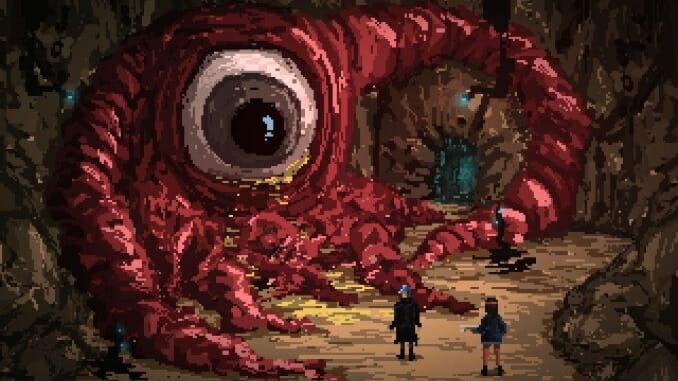Usually, when a game enters an early access program, it’s for two reasons: to build interest before the official release, and to gather player feedback to polish the game. In the case of Death Trash, my only feedback is this: you are perfect the way you are. Don’t ever change.
Now available on Steam, Death Trash is everything I love about Fallout (and the very few things I enjoyed about Zelda II). It’s crude, dark, and just a little gross. And it combines exploration with RPG conventions to create a complex ecosystem of dialogue, side quests, and random encounters that are unique to each playthrough. So far, the game has gotten a lot of praise for its use of the early Fallout formula. And while Death Trash deserves to stand on its own feet, I can’t help but add to the chorus. For those of us missing the glorious complexity of open-world storytelling, Death Trash is a welcome return to form.
Set in a post-apocalyptic wasteland, the game tells the story of an exile from a mysterious society of machines who is thrust into a desert inhabited by cultists and Titans made of flesh. As they try to figure out who they are, why they were banished, and how to survive this strange new place, they meet all sorts of characters, from self-serious cultists, disfigured monsters, and roaming bands of god-killers. Equal parts survival and occult horror, the game’s RPG format is based on standard character-building conventions like skills and attributes, which are reimagined to fit neatly into Death Trash’s themes. Traits like Occultism, Cybertech, and Animalism give the player better tools both to navigate the wasteland’s challenges and better understand the world around them. Cybertech, for example, can help unlock and use technology or machines, while Animalism is used to communicate with sentient mounds of flesh, which can be used as a weapon in combat. Crafting, meanwhile, keeps the player well-stocked, using everything from local flora, metal, and yes, the titular trash to find purpose as a weapon or healing item. Items are made in the inventory screen, letting you quickly build what you need on the fly.
Visually, the game’s art style is its strongest draw, using a dusky twilight palette and chunky textures to evoke a disparate bleakness with the sparseness of detail. The overworld map is also the best place to enjoy it, with fiery crags and lakes of lava hinting at dangerous adventures to come. Here (like Fallout), players can travel, explore and discover new places, but also (perhaps more like Zelda II), run into random encounters from other incoming NPCs,
prompting new combat, lore, or side quest opportunities. Some levels occur in closed, high-tech facilities where the action becomes a strategic, fast-paced trial and error process reminiscent of games like Hotline Miami. Others remain in the open desert, where the player uses an arsenal of traps and distractions (including the ability to puke on command). This combined use of micro and macro locations, like the pixel art itself, creates an appealing impression of scale. As the thread of storylines and side quests begin to entangle, the world seems much bigger than its flat, isometric style suggests. While the game is not the open-world format that exploration games usually rely on, it still feels like open-world exploration. Together, the art and the overworld map create that same tentative thrill of possibility.
Death Trash has a lot of obvious sources of inspiration, and it wears them well. For all its conventions, their combined use feels sincere rather than formulaic, a welcome reminder that for all its emphasis on “forward” progress, game design isn’t always necessarily linear—and nor should it be. The industry has always placed a high value on pushing the technological envelope with each successive console generation. But some of the most interesting and thought-provoking work of the past 15 years has been in the reinterpretation of old conventions and aesthetics. Death Trash is compelling not despite its rough edges but because of them.
I play Fallout games every day, and yet I didn’t realize how much I missed the original Fallout until I played Death Trash. I don’t know what I’ll do with myself until its full release. The game has received publisher support in the past few years, but the final product won’t come out until at least next year. And while the demo clocks in at a generous 10 hours, it’s just not enough, especially if you’ve suddenly become greedy for old-school mechanical and narrative complexity (which I have, and I am). Who knew that dusting off a few old classic game conventions could be so fun? I guess one man’s trash really is another man’s treasure. For me, that treasure is Death Trash.
Holly Green is the editor-at-large of Paste Games and a reporter and semiprofessional photographer. She is also the author of Fry Scores: An Unofficial Guide To Video Game Grub. You can find her work at Gamasutra, Polygon, Unwinnable, and other videogame news publications.
